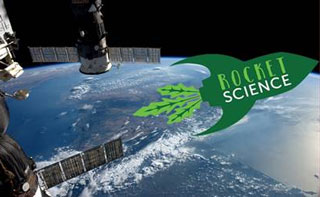Primary Times - the definitive what’s on and where to go family guide of activities and events for children of primary school age. Things to do with your kids during the school holidays including arts and craft activities, music and theatre for children, parties, competitions, days out, and family attractions along with term time drama schools, dance classes, after school clubs and sports activities. Things to do at a place near you!
UK Sending Seeds to International Space Station as Royal Horticultural Society (RHS) and the European Space Agency Name Top 10 Plants for Space
 Yesterday 2kg of rocket seeds (Eruca sativa) were launched into space where they will spend the next few months on-board the International Space Station (ISS) before being returned to the UK for a nationwide experiment.
Yesterday 2kg of rocket seeds (Eruca sativa) were launched into space where they will spend the next few months on-board the International Space Station (ISS) before being returned to the UK for a nationwide experiment.
The seeds, due to arrive at the ISS on Friday morning, were successfully launched from Baikonur, Kazakhstan on Soyuz 44S – the flight that is delivering European Space Agency astronaut Andreas Mogensen and his crew to the ISS. They will be returned to Earth with Scott Kelly, currently planned for March 2016.
The seeds have been sent as part of Rocket Science, an educational project launched by the RHS Campaign for School Gardening and the UK Space Agency. The project will allow up to 10,000 schools the chance to grow these seeds in 2016 for a UK-wide science experiment which will also enable young inquisitive minds to think more about how we could preserve human life on another planet in the future.
Official applications for teaching resource packs containing the seeds will open on Monday 14 September for schools that have pre-registered their interest. Applications will then open for remaining schools on Monday 21 September if remaining packs are available. Schools can still pre-register their interest on the RHS Campaign for School Gardening website up until Monday 14 September. Two teaser resources, a literacy exercise for primary aged pupils and a science lesson on genetics for secondary students, will also be made available online for schools to download.
The 2kg of seeds that flew today are replacements for the ones that were lost when the Falcon 9 rocket carrying the Space X 7 cargo spacecraft exploded shortly after launch on 28 June 2015.
To coincide with the project, a team of European Space Agency (ESA) scientists working on the MELiSSA project* has created a list of the top 10 plants to grow in space, offering an insightful guide to providing food and maintaining psychological wellbeing for future astronauts. For any keen gardeners looking to grow some of these crops at home, scientists at the RHS have also suggested some Earth-grown cultivars that could be grown on an alien planet.
- Soybean: Soybeans are amazingly rich in protein and oil, and can be made into products such as soy sauce, while the immature pods are eaten as edamame. Dried soya can be found in many other foods and drinks, as well as essential products from paper to adhesives. After processing, the oil from the seeds can also be used as a diesel fuel – what a useful plant to grow in space! Crops grown in the UK include ‘Envy’ and ‘Ustie’ could be well-placed to grow in less than optimal off-world conditions.
- Potato: Humble they may be, but few crops produce as much food per square metre. Although mostly carbohydrate, they contain high-quality protein and useful amounts of vitamin C. Older varieties are often robust, water-efficient and high yielding, if not so easy on the eye. ‘Pentland Crown’ remains a firm favourite for difficult conditions and makes a great baked potato.
- Rice: Rice feeds nearly half of humanity, and it would be unthinkable to leave this behind. Paddy rice (grown in water filled paddy fields) might be tricky in space, so perhaps the much less important dry land rice (grown in dry soils) would be the interplanetary choice.
- Soft white wheat: Used to make many of the staples of our diet, from bread and pasta to couscous. Modern British wheats are bred by specialist companies for use in mechanised farming and as such carry royalties. Rather than returning astronauts facing a hefty bill, we suggest working with the International Maize & Wheat Improvement Centre, who can advise on royalty-free wheats that can withstand arduous conditions and have little straw content.
- Tomato: Tomatoes are a must. Imagine life without this tasty, vitamin rich succulent fruit. It can be eaten out of hand or used in cooking. Good cultivars include the bushy ‘Red Alert’ that is extremely fast growing, producing abundant small sweet fruits. Popular greenhouse tomatoes such as ‘Alicante’ owe their popularity to their reliability. For Mediterranean flavours and large fruits 'Costoluto Fiorentino' is also popular.
- Spinach: Spinach is quick-growing, can be eaten raw or rapidly cooked, and its sharp flavour would be especially welcome on long voyages. Astronauts would be wise not to gorge, however, as the oxalic acid it contains can limit dietary uptake of calcium. ‘Giant Winter’ Spinach is hardy and robust, but if a hotter planet is encountered then we’d do well to consider ‘Medania’, an older cultivar that remains popular.
- Lettuce: Quick and easy to grow, produces limited waste, and refreshingly fresh tasting, an important point for travellers confined to their craft for long periods. Lettuce was originally grown for its oil rich seeds and these too might be valuable in space. Traditional favourites such as ‘Little Gem’ (small cos), ‘Lobjoits Green’ (large cos) and ‘Continuity’ (butter head) are reliable under the most unpromising conditions. Cos, also known as red romaine, was recently grown and eaten on board the ISS, marking the start of the ‘veggie project’ that will see more food grown in space.
- Beetroot: Beetroot is a sweet, tasty and nutritious root crop, and its leaves make a filling, robust spinach-like vegetable. In theory sugar beet would be a heavier yielding, but of little use in space where processing factories are few. ‘Detroit 2’ and ‘Bolthardy’ are both good quality and heavy cropping.
- Onion: Lengthy missions would be dull indeed without these sweet, nutritious, flavour enhancing vegetables. They also have an analeptic (stimulating) effect on the central nervous system helping to keep astronauts alert. Onions like a hotter, sunnier climate, so varieties that perform well in Britain should grow anywhere. For succulent spring onions ‘White Lisbon’ is ideal while the traditional ‘Bedfordshire Champion’ is perfect for tear-inducing brown ones.
- Spirulina: Not very appetising but in the worst case scenario space explorers would be able to survive on this green micro-alga. Harvested form the ocean, it is protein rich and efficient at producing oxygen from waster carbon dioxide breathed out by the crew
Rocket Science officially launched at the RHS Chelsea Flower Show in May with a large interactive exhibition stand. Visitors to the stand were encouraged to vote for the crop they felt was the most important to take to space. Over 5,000 visitors took part in the vote with many basing their choice on their personal favourite to eat. Others made their decision after considering the practicalities of growing a particular crop in space or which would be the most valuable and useful. After six days of decision-making, the results showed the nation’s favourite crop to take to space is the tomato, which won 19% of the vote. This was closely followed by potatoes (17%) and beetroot (12%). It is no surprise since tomatoes are a popular choice and a versatile crop for everyday cooking. For space travel, as well as being a good source of essential vitamins and minerals, they could also be an important comfort food for astronauts and provide the feel good factor on long-term missions.
Rocket Science is just one educational project from a programme developed by the UK Space Agency to celebrate British ESA astronaut Tim Peake’s Principia mission to the ISS. Registrations of interest for Rocket Science are being accepted at the RHS Campaign for School Gardening website rhs.org.uk/schoolgardening and official registrations for seeds will open in September 2015.
British ESA astronaut Tim Peake said: “It’s a huge privilege to be the first British ESA astronaut flying to the International Space Station. During my six-month tour I’ll be conducting a number of experiments on the International Space Station, and I hope that Rocket Science will inspire the next generation to think scientifically, and to consider the fulfilling careers in science and technology.”



